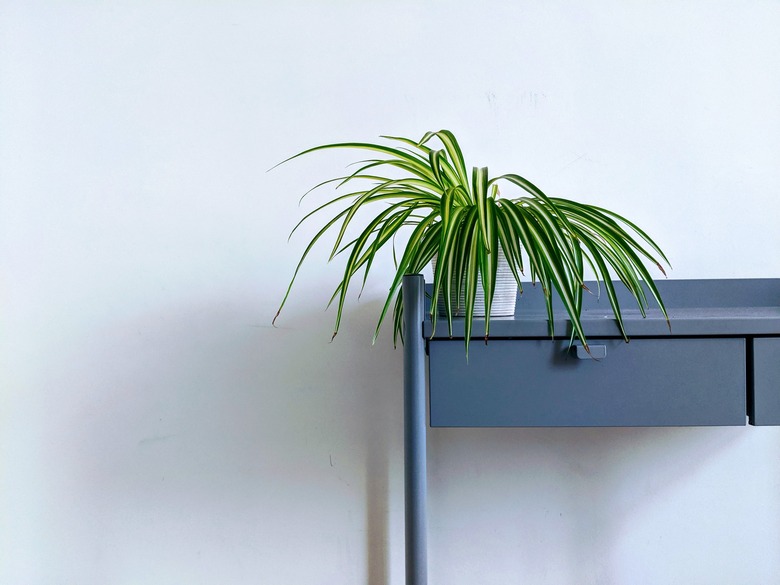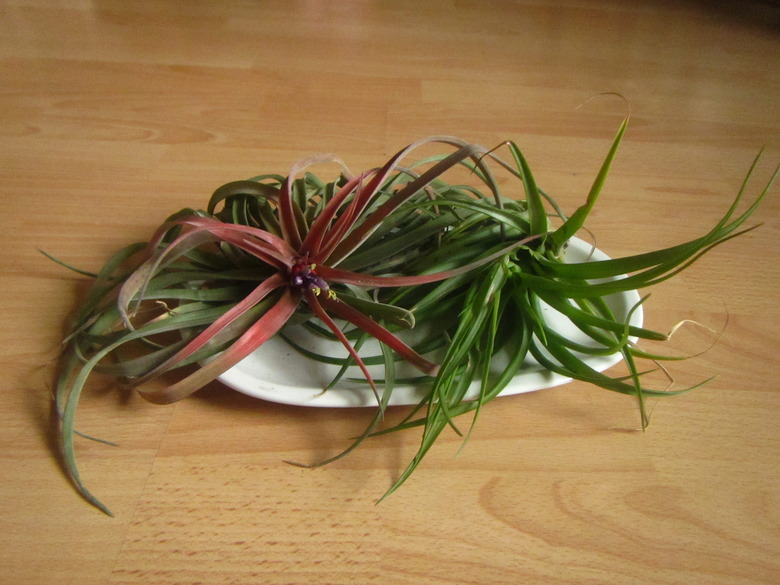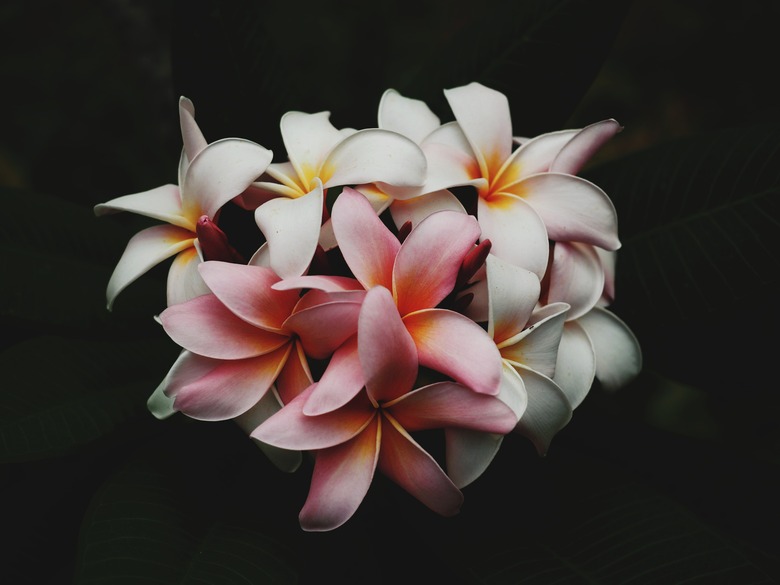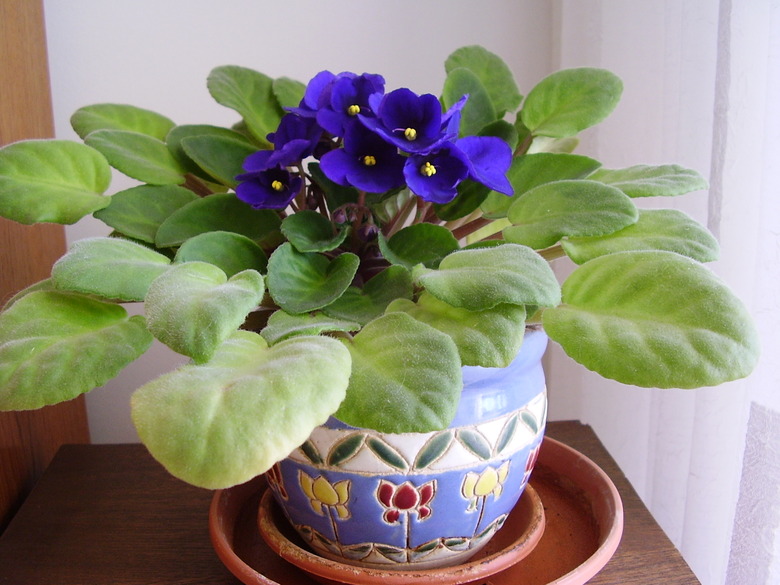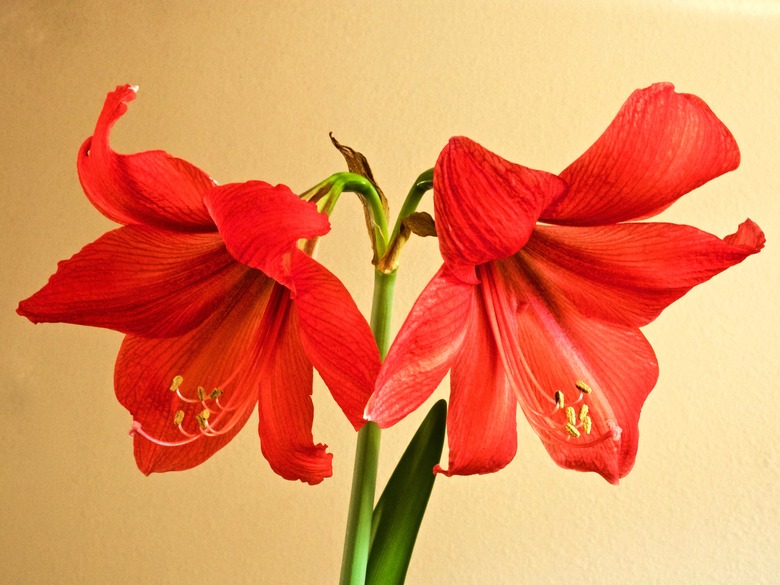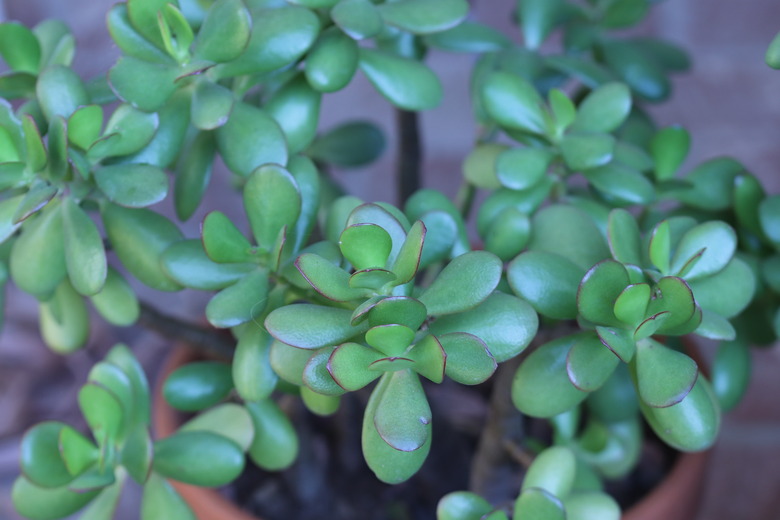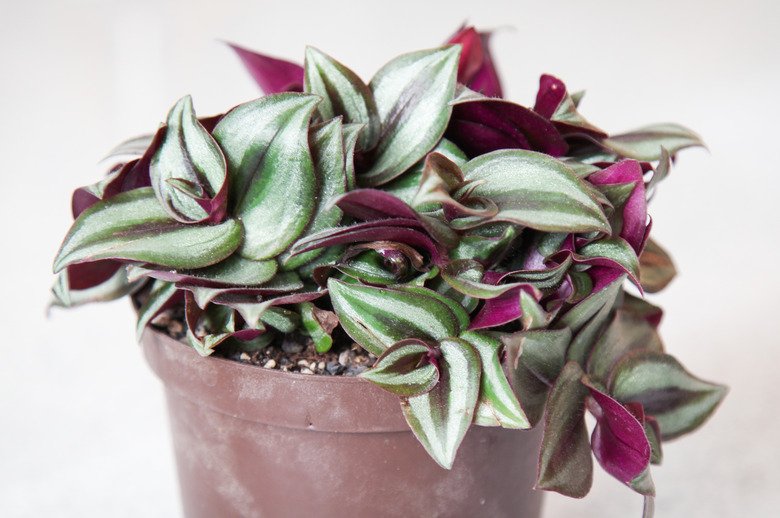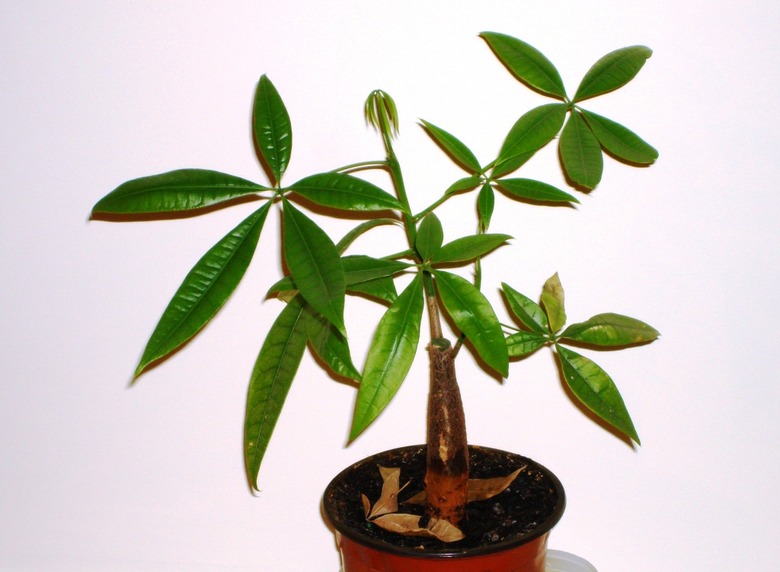How To Identify Types Of Houseplants
The lovely plants that thrive on a windowsill, trail from a hanging pot or fill a brightly lit corner range from friendly little flowers to towering trees. It's important to identify houseplants to ensure that they receive the correct amount of warmth, light, water and fertilizer.
While most common houseplants are tropical plants, hardy in U.S. Department of Agriculture zones 9 through 12, a few can be grown outdoors in colder climates.
When a family member, friend or neighbor provides a cutting or seedling, they may refer to the plant by a common name. Common names may be shared by several plant species, so they are not a good indicator of the care that a particular plant needs in order to grow in the home.
Learning How to Identify Houseplants
To identify a house plant, begin with a pencil, paper and measuring tape. Take time to document the size, leaves, flowers and so on before sitting down and perusing the internet or an illustrated guide to houseplants.
Though a picture does speak a thousand words, it can also be confusing if the image is a close up of a leaf or flower instead of life size. If possible, take a picture and zoom in as needed to match the image size on the website or in the book.
The size of an indoor plant is an important element, not only in identification, but in ensuring that it has enough room to grow. A tree may start out small, but grow 15 or more feet tall unless pruned regularly.
Unless growing a tree as a bonsai, a smaller or slow-growing species may be advisable for an office plant or to tuck into a windowsill. Trailing plants generally thrive when allowed to follow their normal pattern, hanging from a basket or sprawling over the top of a bookcase.
Leaves: Size, Shape and Color
Leaves can help identify a plant by size, shape and color. The leaves may be green, gold or other color and/or variegated with lighter undersides. They may vary in texture from feathery to fuzzy to rubbery, and in size from tiny to huge.
Some plants have brilliant splashes of color splattered across the leaves, making them easy to identify despite varied leaf sizes, shapes and colors, while others have simple oval or oblong green leaves. Examine and document the leaves by:
1. Measuring the length and width of the leaf. 2. Observing if the edges are toothed or smooth. 3. Noting the shape of the leaf—oval, oblong or long and thin. 4. Comparing to known leaf types. 5. Checking if the leaves are smooth, crinkly or fuzzy and if the veins on the underside are prominent, parallel, netted or a different color. 6. Documenting the width and thickness of the leaf, if it is thin and stiff or thick and fleshy.
Stems: Shape, Color and Sap
Stems can also be an indicator of species. Shape, color, or whether the stem is woody or herbaceous, all can help identify a plant. Succulents have thick, fleshy stems while shrubs and trees feature woody trunks and bark.
The type of sap can also help identify a plant. Some plants produce a white, milky sap when the stems are broken or cut.
Flowers: Size, Colors and Scents
While not all popular houseplants produce flowers, the blossoms can quickly lead to the correct identification. The size, color, shape and fragrance are all identifying factors. Document the flowers by:
1. Counting and measuring the petals and flower size. 2. Looking at the flower growth pattern: individual blossoms, flower spikes or clumps. 3. Noting the flower parts and colors. 4. Smelling the flower to see if there is any scent.
Warning
While not all plants that ooze a thick, latex-like sap are toxic, they may still cause allergic skin reactions as well as harming eyes and mucus membranes. Wear safety gear, including gloves and safety goggles, when working with these types of plants and keep them out of reach of children and pets.
Choosing a Houseplant
Whether a gift or purchased locally or online, choosing the right houseplant for the indoor garden varies wildly, depending on the plant's needs and homeowner's aesthetic.
A modern décor may be enhanced by a spiky succulent, while an office can host a friendly little flowering plant or a lucky tree. Hanging trailing plants add greenery without taking up extra space in a small home. When choosing a houseplant, consider:
- Available light, whether low light conditions, bright or indirect sunlight.
- Indoor temps, whether cool or warm.
- Accessibility to children and pets.
In general, there is an easy-to-grow plant that will fit into nearly every home.
Epiphytes for Indoors
Unusual and beautiful plants that evolved to grow above the ground on tree trunks and branches include epiphytes like moth orchids (Phalaenopsis spp., USDA zones 10 to 12). The easiest orchid for beginners, they feature arching stems with multiple white, pink, yellow or multi-colored blossoms. Bright filtered light and weekly or biweekly watering keeps these tropical flowers blooming for weeks at a time. The identifying characteristics of moth orchids include:
- Flower stems up to 18 inches long.
- Five-petal, 3- to 6-inch-wide flowers.
- Large, leathery, dark green leaves that rise directly from the roots.
- Small root ball with fleshy roots that may climb out of the flowerpot.
While not all bromeliads (Bromeliaceae family) are epiphytes, there are a number of species grown as houseplants. Air plants (Tillandsia spp., USDA zones 10 to 12) are among the easy-care bromeliad species. Plant care includes watering by soaking the entire plant in a bowl of water for two hours every week or two and/or misting regularly. While air plants' foliage and flower colors vary, they have several identifying characteristics:
- No need for soil; they can be mounted on driftwood or other support.
- Twisted mass or rosettes of thin leaves which may be green or covered with silver-gray scales.
- Flowering species may have bright pink stalks with white, orange, red, blue or purple blossoms.
Exotic Focal Points
Plumeria (Plumeria spp., USDA zones 10 to 12), often called frangipani, is a group of 11 flowering shrubs and trees. The fragrant flowers are used for leis in Hawaii. Each plumeria species has its own distinct forms and flower colors, but there are a few universal identifying characteristics:
- Thick, succulent trunks and branches with thin bark.
- Leathery or fleshy leaves that grow in clusters on branch tips.
- Fragrant, five-petal, 2- to 4-inch tubular flowers in clusters.
- The production of milky sap when branches are broken or trimmed.
The brilliantly colored foliage of crotons (Codiaeum variegatum, USDA zones 11 to 12) make them a focal point in the garden and inside the home. While frost tender, some homeowners allow their indoor houseplants to enjoy a summer vacation on the patio before bringing them inside for the winter. Crotons can grow up to 6 feet tall and equally wide under ideal conditions. While the leaf sizes and colors may vary, depending on the cultivar, common identifying features include:
- Leathery, glossy leaves that may be up to 18 inches long, oval, oblong or narrow and pointed.
- Differing color, depending on cultivar, but most crotons have brightly colored leaves striped, speckled or splashed with yellow, orange, pink, red, bronze and other bright colors.
- Upright growth pattern.
- Broken stems and leaves that ooze a milky, latex-like sap.
Friendly Little Flowers
Whether on an office desk or on the table at home, African violets (Saintpaulia ionantha, USDA zones 11 to 12) are friendly little flowers that enjoy the same indoor environment as humans. Keep these small plants flowering year round with bright filtered or indirect light, an acidic and well-draining potting mix and regular watering to keep the mix evenly moist but not waterlogged—just be sure to avoid wetting the leaves. The primary characteristics of African violets include:
- Oval, dark green leaves with a hairy or fuzzy surface.
- Violet-like white, pink, blue, violet or bicolor flowers.
- Compact growth at only 6 to 9 inches tall and wide.
A member of the same plant family as African violets, tropical gloxinias (Sinningia speciosa, USDA zones 11 to 12) produce showy white, red, purple, lavender or bi-colored flowers, or in the case of hybrids, a variety of pastels. Gloxinias may be identified by:
- 4-inch-wide trumpet-shaped flowers.
- A rosette of oval to oblong velvety green leaves.
- Larger than African violets, at 6 to 12 inches tall and wide.
- Goes dormant after flowering; new growth appears in winter.
The bright yellows, pinks, oranges and reds of gerbera daisies (Gerbera jamesonii, USDA zones 8 to 10) add a cheerful ambiance to the office or home. While these daisy-like perennials thrive in mild winter climates, they are also potted and used as houseplants in bright indirect light or near brightly lit windows. Some characteristics of gerbera daisies include:
- Single or double, 3- to 6-inch-wide flowers with a yellowish, bronze to black center floral disk.
- Leafless flower stems rising 6 inches above the center of the plant, with one flower per stem.
- Up to 20-inch-long, lobed, slightly fuzzy leaves that grow in a 12-inch-wide clump.
Home for the Holidays
The winter holidays are filled with bright flowers, including amaryllis (Hippeastrum hybrids, USDA zones 8 to 10). The red, pink or candy-striped amaryllis flowers grow from large bulbs placed in bright filtered light and watered regularly. Planted at Thanksgiving, the plants are ready to flower by Christmas. Amaryllis can be identified by:
- Bulb size, usually 2 to 4 inches wide.
- 12- to 18-inch-tall flowering stems.
- Two to six, 4- to 6-inch-wide, trumpet shaped flowers.
- Dark green leaves that appear when the flowers open.
Poinsettias (Euphorbia pulcherrima, USDA zones 9 to 11), natives of Mexico, are found everywhere during the holidays, adding to the festivities with their bright red, pink, yellow, cream or bicolor bracts. While the poinsettia is actually a deciduous shrub that can grow up to 12 feet tall and 8 feet wide in warm climates, it needs regular watering and bright light to thrive when the holidays are over. A poinsettia plant can be identified by observing:
- Colorful bracts surrounding tiny yellow flowers.
- Large oblong green leaves with pointed tips, may have shallow, blunt teeth on the edges.
- Leaf stems may be reddish or green.
- Latex-like white sap oozing from cut or broken stems.
- Woody main stem or trunk.
The holiday cacti (Schlumbergera spp., USDA zones 10 to12) produce white, yellow, pink, magenta or bi-color flowers. These tropical epiphyte cacti produce flower buds when provided 13 hours of complete darkness every night for approximately three months before the holidays. Keeping night temperatures between 45 and 55°F also results in flower bud formation. To identify these plants, look for these characteristics:
- Thick and flat stem segments growing in "chains" instead of leaves.
- Segment edges may be smoothly indented (Christmas cactus, Schlumbergera x buckleyi or S. bridgesii), sharply toothed (Thanksgiving cactus, S. truncata) or subtly rounded with tiny hairs between the segments (Easter cactus, S. gaertneri).
- Each segment may grow up to 2 1/2 inches long and 3/4 inch wide.
- Orchid-like flowers that appear at the end of segment chains.
Succulents and Cacti
Succulents and cacti are often difficult to definitively identify, but there are a few species that family and friends share with anyone who'd like a cutting. Jade plants (Crassula ovata, USDA zones 10 to 12) are relatively low-maintenance plants and drought tolerant, but prefer regular watering without overwatering. To identify a jade plant, look for these characteristics:
- Thick oval or oblong shiny green leaves, 1 to 3 inches long and 3/4 to 1 1/2 inches wide with smooth and sometimes reddish edges.
- Multiple sunken stomata, or pores, on the leaves.
- Thick, gnarled trunk and branches with peeling bark on mature plants.
- White flowers with four to five narrow petals on reddish stems.
Aloe vera (USDA zones 10 to 12) is another succulent that is often shared, in part due to its traditional use in soothing burns as well as its air purifying properties. Grown in a sunny kitchen window, the gel-like sap inside the plant can be liberally applied to burns. However, sensitive individuals may have a skin reaction to the gel; keep this plant out of reach of children and pets. When identifying aloe vera, look for:
- Up to 18 inches long and 1 to 3 inches wide, thick and fleshy, green to blue-green leaves with white-toothed edges and pointed tips.
- Leaves grow in a rosette from a short and thick stem.
- Thick gel-like interior.
- Yellow-orange or red 1- to 3-inch tubular flowers in a dense cluster on top of a 2- to 3-foot spike.
With its tall, spikey leaves, the snake plant (Dracaena trifasciata, formerly Sansevieria trifasciata, USDA zones 10 to 12) is a drought tolerant, easy-care succulent suited to beginners. However, like other dracaenas, it should be kept out of reach of children and pets as it can result in gastric distress if ingested. A snake plant can be identified by:
- Stiff, upright, tall (up to 4-feet) and 2- to 4-inch-wide leaves.
- Alternating bands of green and cream on the leaves.
- Some cultivars' leaves are also edged in yellow or cream.
Trailing Plants for Hanging Baskets
The spider plant (Chlorophytum comosum, USDA zones 9 to 11) features long thin leaves, multiple "babies" and sometimes flowers cascading from the flowerpot. One of the best indoor plants for air purifying and easy plant care, spider plants produce babies that are easily snipped from the parent plant and popped into their own flowerpots. To identify a spider plant, look for:
- Green or green-and-white striped leaves, 12 to 18 inches long and 1 to 3 inches wide.
- Brown leaf tips if watered with chlorinated and/or fluoride-treated water.
- Arching stems with plantlets.
- Yellow or white, six-petal, 1/4-inch-wide star-shaped flowers, in clusters on the tips of the stems.
While the Boston fern (Nephrolepis exaltata, USDA zones 10 to 13) suffers from brown tips if exposed to direct sunlight or dry air, its fronds provide a mass of lush lacy foliage best viewed as a hanging plant. Growing up to 3 feet in diameter, Boston ferns need high humidity and evenly moist soil. This fern is among the plants that help remove indoor air pollutants. Characteristics to look for when identifying this tropical fern include:
- Erect and arching, 2- to 3-foot-long fronds that taper to the tips.
- Compound pinnule leaves arranged alternately on the brown stems of the frond.
- Leaves may be green or variegated, and some cultivars have ruffled foliage.
- Brown spore cases (sporangia) lining the underside of each leaf.
The zebra plant (Tradescantia zebrina, USDA zones 8 to 12), also known as "inch plant" and "wandering dude," features variegated leaves and occasionally flowers. Provide bright filtered light and evenly moist soil for the brightest foliage. The 1- to 2-foot-long trailing stems and showy leaves need regular trimming, providing cuttings to make more plants. When identifying which Tradescantia species is growing in the window, look for:
- Striped, green, white, silver and/or purple leaves with purple undersides.
- Simple 1- to 2-inch leaves alternating on the stems.
- Fine hairs along the leaf edges.
- Rarely, tiny three-petal purple flowers.
Trees in Pots
Grown from seeds or cuttings, with proper care citrus trees (Citrus spp., USDA zones 9 to 11) may even produce fruits indoors if hand pollinated. Naturally small, an Improved Meyer lemon tree (Citrus × meyeri) thrives in a sunny corner, and more light can be added with grow lights. Keep the soil evenly moist, but not waterlogged, and prune regularly to keep the tree small. Citrus trees are easily identified by:
- Glossy 3-to-6-inch-long green leaves that may have smooth or notched edges.
- Woody trunk with brown bark, may have thorns.
- Young branches and stems that are green and zig-zag.
- Five-petal white flowers in clusters, with unopened buds that have hints of purple.
- Citrus flowers with their strong, sweet scent.
The pyramid shape and symmetrical soft branches of the Norfolk Island pine (Araucaria heterophylla, USDA zones 9 to 11) make this evergreen tree a popular choice for large entries and sunny atriums. Keep indoor trees evenly moist and turn regularly to ensure even growth of the branches. To distinguish the Norfolk Island pine from other conifers, look for:
- Pyramid shape with a single trunk.
- Whorled branches, with five on each whorl.
- Multiple upright branchlets on each branch, featuring 1/2-inch-long soft but pointed needles.
- Needles arranged in a spiral, scale-like pattern on the branchlets.
Usually found with a braided trunk through local vendors and online, the Guiana or Malabar chestnut (Pachira aquatica, USDA zones 10 to 12) is actually an evergreen tree that grows up to 60 feet tall in the wild. Also known as the money tree or Chinese money plant, this water-loving tropical grows 6 to 8 feet tall when grown indoors. Locate this tree in bright filtered light and water regularly to keep it healthy. Identifying characteristics include:
- Large compound leaves with five to nine 5- to 10-inch shiny green leaflets.
- Trunk that has rough brown bark, with stems that are smooth and green.
- Flowers that rarely bloom indoors. Each is greenish to yellowish with five curled petals surrounding 3- to 4-inch-long red-tipped stamens that resemble a shaving brush.
- Fragrant flowers that bloom for one night.
References
- The Ohio State University: Houseplants for Everyone
- Oregon State University: Plant Identification: Examining Leaves
- Oregon State University Extension Master Gardener: Houseplants for Everyone
- Missouri Botanical Garden: Phalaenopsis (Group)
- Wisconsin Horticulture Division of Extension: Plumeria
- North Carolina Extension Gardener Plant Toolbox: Codiaeum variegatum
- Missouri Botanical Garden: Saintpaulia ionantha
- Missouri Botanical Garden: Sinningia speciosa
- North Carolina Extension Gardener Plant Toolbox: Gerbera jamesonii
- Missouri Botanical Garden: Hippeastrum (Group)
- North Carolina Extension Gardener Plant Toolbox: Euphorbia pulcherrima
- Missouri Botanical Garden: Schlumbergera × buckleyi
- North Carolina Extension Gardener Plant Toolbox: Crassula ovata
- North Carolina Extension Gardener Plant Toolbox: Aloe vera
- North Carolina Extension Gardener Plant Toolbox: Dracaena trifasciata
- North Carolina Extension Gardener Plant Toolbox: Chlorophytum comosum
- North Carolina Extension Gardener Plant Toolbox: Nephrolepis exaltata
- North Carolina Extension Gardener Plant Toolbox: Tradescantia zebrina
- Missouri Botanical Garden: Citrus × meyeri
- North Carolina Extension Gardener Plant Toolbox: Araucaria heterophylla
- Missouri Botanical Garden: Pachira aquatica
